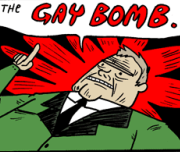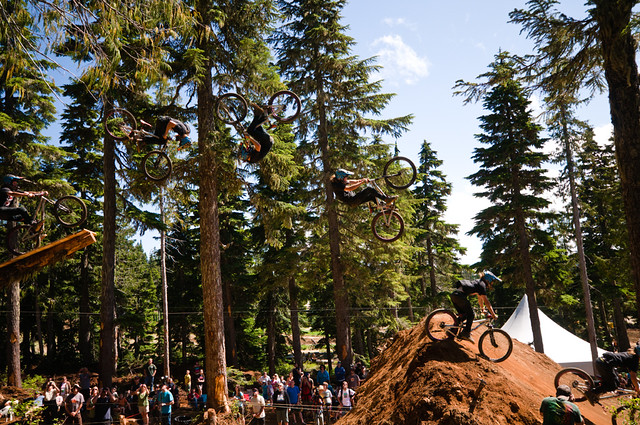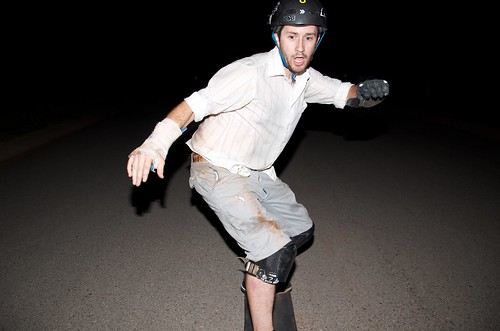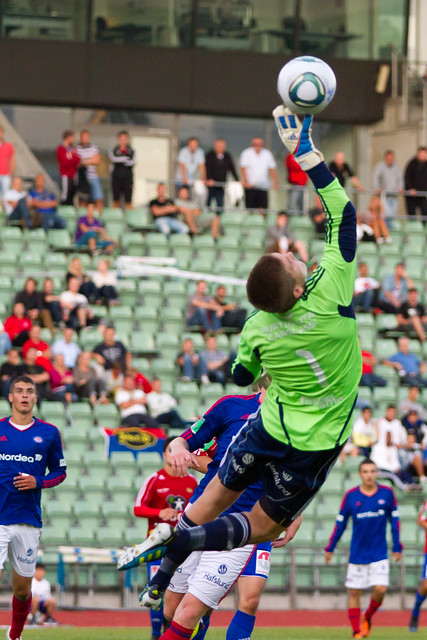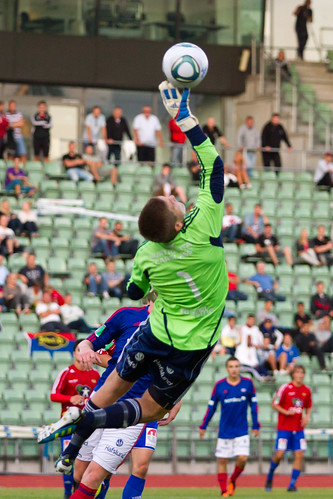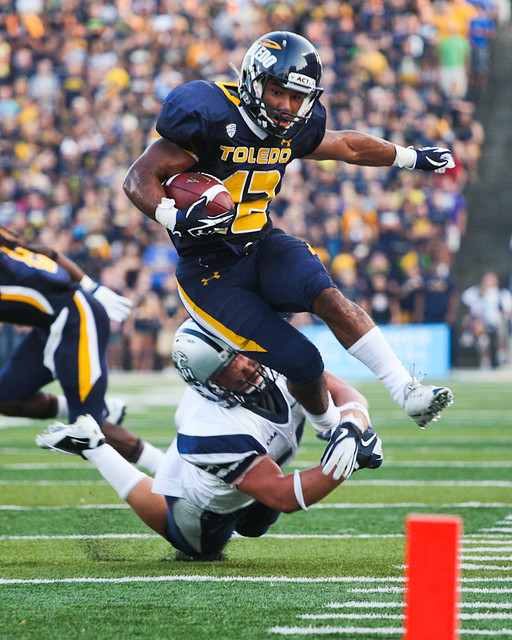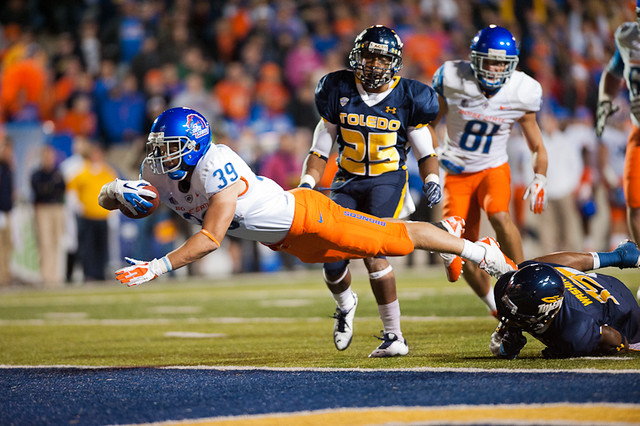|
So do you like photography but feel the need to spend more obscene amounts of money on things like a 400mm f/2.8? Do you want to rip your hair out under lovely lighting at high school stadiums and ice rinks? Do you want to take 300 panning shots only to have about 5 turn out good? WELL CONGRATULATIONS SPORTS PHOTOGRAPHY IS FOR YOU  But DJExile, why should we shoot sports photos? Sports provide a great blend of action, emotion, and crazy That sounds awesome! But I hear it's expensive and all I have is my consumer-level body and a kit lens! Unfortunately, yes. By and wide, sports photography is the most expensive realms of photography and you can very easily drop thousands of dollars on equipment. I'm going to hand this list of what you can expect to need over to JAY ZERO SUM GAME posted:You need the following: I would also recommend adding some sort of weather protection if you're shooting outdoor events. The OP-Tech Rainsleeves are cheap as dirt and are fantastic in a pinch. No reason not to have one in your bag. There are also bigger, fancier rain jacket/cover things for your huge "I'm watching you pee from 3 zip codes away" telephotos out there. Consumer-level bodies have improved over the last couple years and you can get some decent shots with them, but you'll quickly find yourself wanting faster AF, faster burst speed, faster glass. Speed is almost always the name of the game in sports photos. Keep a close eye on used listings at places like KEH, B&H, Adorama, Craigslist, Ebay, etc. A good chunk of my equipment nowadays is either used or refurbished, and that can save you a significant amount of money. I found a used 40-150mm f/3.5-4.5 for $110 that served me incredibly well as my first sports lens for about a year and a half. This was taken on an Olympus E-410, one of their most basic entry-level DSLRs. 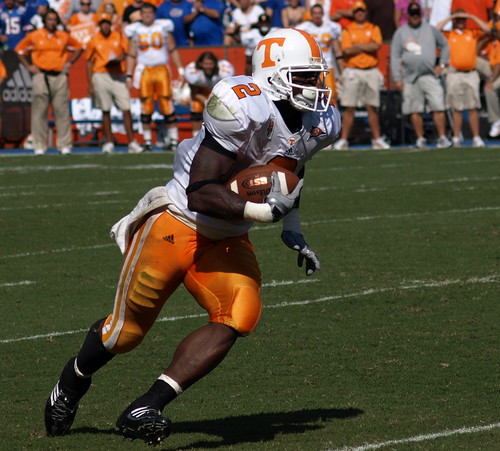 Obviously costs will also vary based on what you want to shoot. Smaller fields of play like baseball fields (well, the infield anyway), basketball courts, and ice rinks will usually not require anything longer than 100-150mm. Keeping to outdoor events in sunlight will let you get away with things like a 70-300mm f/4.0-5.6, which would be pretty much useless indoors or in bad light. 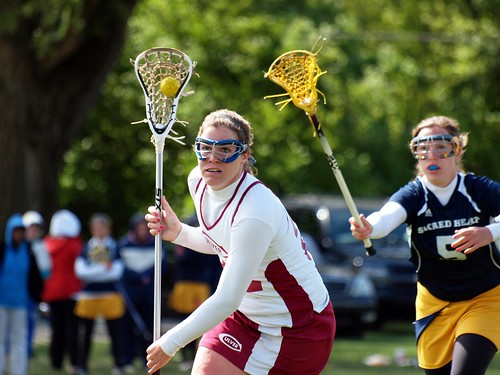 This all being said, light is rarely ideal and more often ranges between "cloudy but decent" and "GOD DAMNIT THIS loving ICE RINK". You're going to need reasonably fast glass. f/2.8 or better in many cases. Fast primes like a 50mm or 85mm f/1.8 have uses in a basketball or hockey arena, and at field sports they can be good for shots along the sidelines of coaches, trainers, fans, etc. Even if all you have is a kit lens, you can still put it to use in some of those situations. E: I almost forgot: There's no reason to ever leave burst fire, and as such, you are going to fill up smaller cards very fast. I would recommend at least a 4GB card in your camera, with a couple backups ready to roll. I have a 16GB (probably overkill but I got a good deal on it) and 8GB card with me. Having faster speed cards is always nice as well, especially when you're going to be copying them over to your computer, but between the two, capacity is always the priority. OK, so say I get all this stuff and I want to go shoot sports, how do I get in? In drat near anything more official than a local beer-league softball game, you're going to need credentials or permission of some kind. This isn't always as difficult as it sounds. You could work for a school newspaper, talk to league, arena/stadium, school, or team officials. Congrats! Now you have credentials and/or permission! ACT LIKE YOU BELONG. Nobody is going to care if they get in your way, and ushers and managers will toss your rear end out in half a second if you mouth off to them. You're on the low rung of the ladder at these events, that's just the way it is. Being friendly to them (or at least just polite and professional) can make your life easier. Don't lie, don't make poo poo up, and don't be sneaky. 9 times out of 10, a smile and some simple honesty (and a promise to stay out of the way) will get you a lot further in these situations. It bears repeating to ALWAYS WATCH THE PLAY, EVEN IF YOU ARE NOT SHOOTING. I believe you get kicked out of an NFL stadium if you turn your back to the play. Stadiums/teams/arenas are not responsible for you getting your rear end run over by football/basketball players, or if you pull an Ian Laperierre. I'm in! Awesome! Now what do I do? Know your sport. You don't have to be an expert on it, but know where the action is going. If you're at a baseball/softball game for example, you know your attention is almost always going to be on the pitcher, batter, or at one of the bases. A lot of capturing good action is being able to predict it, so stay aware (also because poo poo can come your way in a hurry and it's easy to get wiped out by some 6'5" 300lb lineman chasing after a fumble) of the action and think about where it's going to go. The old rule is "If you see the play in your viewfinder, you've already missed it". After a play is over, don't immediately check your LCD to see how you did. Your pictures will still be there later and in between play is when you can find players/coaches/fans reacting to bad calls, referees arguing with them, a coach giving players advice during a timeout, a trainer taping ankles, a policeman tasering a streaker... there's usually a lot of fun blink-and-you-miss-it moments. Inevitably, you're going to get into a rut after a while. You can only have so many pictures of a hockey player scoring a goal. Think outside the box. How could you use a really wide angle? What about different angles on the play? What if you spent a quarter/half/game concentrating on shots of anything but the players? What about a very high or very low angle? You'd be surprised what you can come away with sometimes. A collegiate dodgeball tournament actually gave me one of my favorite shots ever when I got low and slowed the crap out of the shutter: 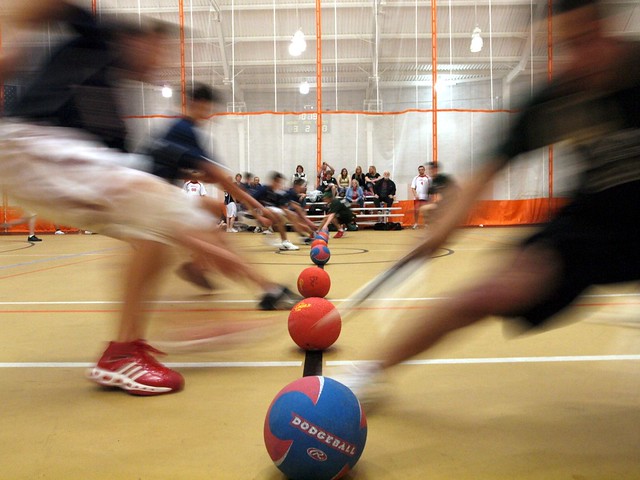 OK so how do I need to set up my camera? I don't want to be fiddling with a lot of settings during the game! Again this obviously depends on the sport you're shooting. In almost every case, your first job is to fill the frame. Yes, you can crop out quite a bit on images most DSLRs give you these days, but better to fill it in the first place. What should be in the shot? Well football photographers go by the old "two faces and a ball" rule of thumb, and it usually works well. It's also drat near always better to see faces in your image instead of backs. For metering and ISO, you know your camera best. I use spot metering a lot in hockey because I don't need to properly expose for ice or dark corners of the arena, I'm mostly concerned about shooting the players. At outdoor events, center or full meter shots are probably going to work fine, but again, you know what works best on your camera. ISO always to suit. The lower the ISO, the less noise you obviously worry about, but the slower the shutter speed. Sometimes you can find a good balance. Sometimes (hockey) you just max the fucker out and worry about it later. As to what mode to set your camera in, it's up to you. I stick mostly to Aperture priority and that works for me. Others are great about making needed adjustments in full manual, while others who are panning to show motion might have it in Shutter priority. Again, you know what works best for you, but don't be afraid to experiment. I'm deleting a ton of my photos! I suck!  Don't let this discourage you. A lot of times you are going to really be pushing the limits of what your camera can do. You're going to miss focus. You're going to mash on auto-fire for 7 shots and only have 1 that works. Don't take it as a slight on yourself that you're coming away with 10-15 decent shots out of a few hundred. Think of the tens of thousands of photos taken by Sports Illustrated, Associated Press, or Reuters photographers at things like the Super Bowl, Masters, Stanley Cup, or other major events, and you only see a small handful in the paper or magazine. Ask questions! Post what you have! A lot of this thread's regulars are good folks and happy to offer any advice they can. It's also really worth checking out our old thread. There are a lot of good tips in there. I'll post up sport-specific ideas and tips later tonight.
|
|
|
|

|
| # ¿ May 1, 2024 23:58 |
|
American Football There's a shitload of things to shoot here. Linemen colliding, WRs and DBs going up for a deep pass, QBs scrambling out of a collapsing pocket, players diving for the end zone, QBs calling out audibles, coaches chewing out officials (OK that's every sport but still...  ) )The tough thing is positioning. Football fields are often very restricted, and big-time venues like Notre Dame stadium, Ben Hill Griffin (Univ. of Florida), Michigan Stadium, and any NFL field are often locked down tighter than Pelican Bay. Photographers are generally allowed anywhere but the benches (those usually being between the 30 yard lines), so it can be difficult getting the action when it moves to around mid-field. Photographers are usually allowed to move freely to any area they like (NOTE: this may be different in the NFL, I'll let Munkaboo or Eeek elaborate if they would like), although it can be tough dodging officials, TV camera crews, and reporters. You'll need to move quickly, and it's very likely you'll be cramming for position with other photographers. It's possible you'll get bumped around by accident. It happens, and again, a little politeness goes a long way. Ushers don't care who's in the right or who's job might be more important. They'll take any reason they can get to toss someone. The sidelines are going to get you most of your shots. Tons of football plays head towards one sideline or another and you can get some great action headed your way on screen passes, QB scrambles, etc. This also often gives you the best angle on handoffs, punts, kicks, and passes, like so: 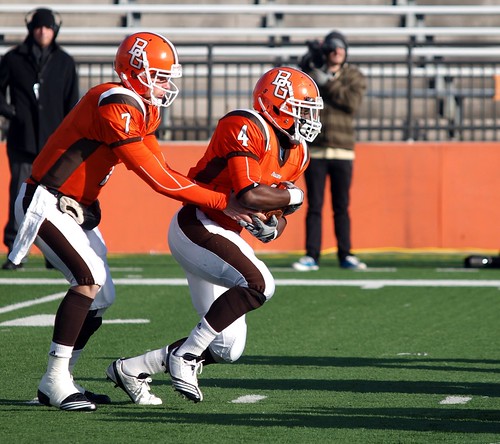 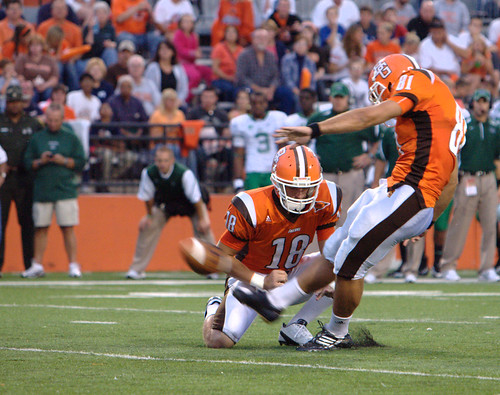 These aren't the best shots by any means, just showing off the angle Often overlooked are the end zones, in part because players going for fade routes are headed straight for you at a very high speed, but you can be rewarded with some fantastic shots of players breaking through the line of scrimmage or headed to the end zone. 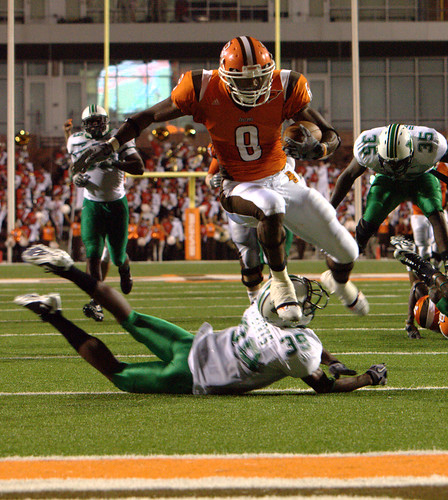 In almost every case as well, sideline/photo credentials will allow you complete access to the field after the game is over. You can use this to catch shots of players shaking hands, congratulating coaches, band playing the alma mater, etc. HOCKEY I loving love hockey. Fast pace, heavy hitting everywhere, flashy goals, killer saves. People punching people. I loving hate hockey. Awful lighting, maxed-out ISO, nearly impossible to get good angles without those cutouts in the glass. Any of you that can shoot hockey well (or at least have well-lit arenas), god bless you. It is a miserable sport to shoot. These bigass florescent lights you see in hockey arenas and basketball courts are a pain to deal with if you don't have strobes, and everything immediately outside the ice/court is usually very dark. In addition, the masks can make getting faces in focus all the more difficult. So what do you do? Start by accepting the following: There is going to be noise in your images. A lot of it. Programs like Noise Ninja and others go a long way in helping, but you're going to have ISO speeds of 1250 to 1600 at the very least in most cases. You can custom WB for a white jersey, or if neither team is wearing them, WB off the ice, but above all else, DO NOT USE AUTO WHITE BALANCE. Your pictures will either come out dark or tinted piss yellow, neither of which help you. Positioning is much tougher here than in football, as you won't have nearly as many places to use. Benches will take up almost all of one side, and bleachers take care of most of the rest of the space. Obviously rinks can really vary from local places to NHL arenas. Most times you'll want to be around the corners where the goal line meets the boards, in order to get angles of players shooting towards the goal. I was lucky enough to find a point just over the edge of the glass on each side of the ice, offering me a pretty decent view of each zone. Ideally I'd be down on ice level but it's not possible in those areas. 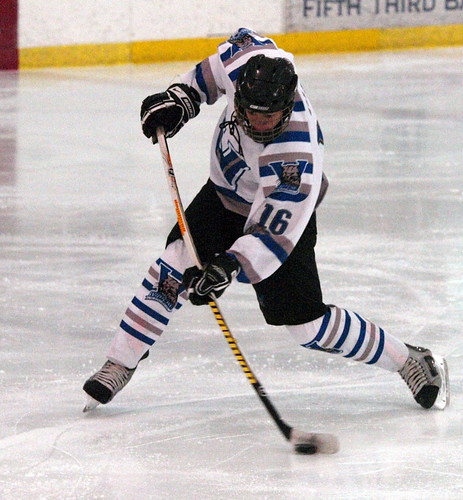 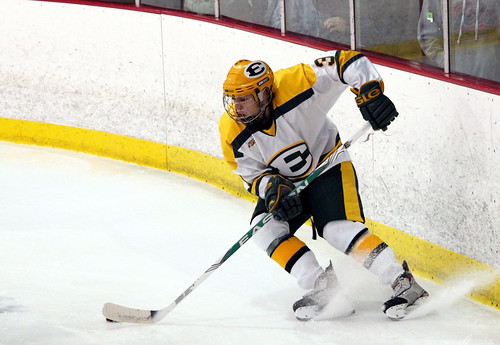 Hockey has a great flow to it, but the players can stop and start very quickly, whether that's from their own agility or running into someone. If you can see some of those moments coming and know exactly when to fire your shutter, that's when you can get the neat looks like the above stick bending and ice shavings kicking up. Thanks to recent rule changes about goalie pad size, pace of the game, etc, goals are pretty common and celebration shots are always a good time. 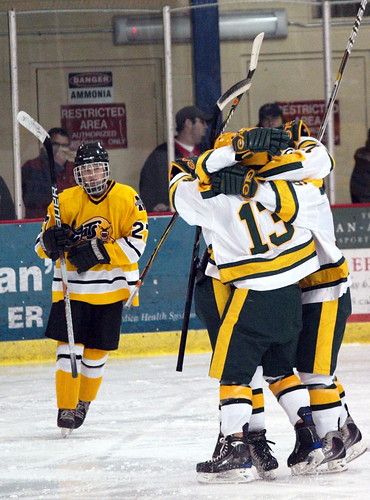 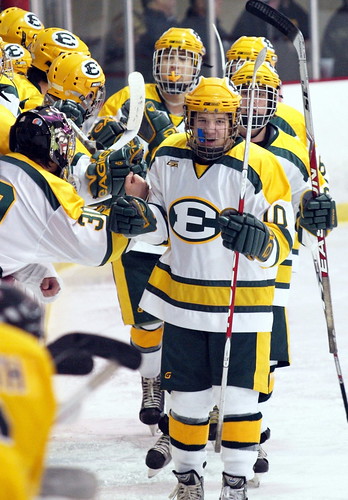 LACROSSE Combine hockey, soccer, and maybe a bit of basketball, and you have lacrosse. Big open field sport like football and soccer, fast ball movement, big hitting (in the mens' game anyway), and tons of scoring. If you haven't seen a game, you really need to. Both teams benches will be on one sideline, which usually affords you the entire other side to work with, although you can still shoot on the bench sides as well. However DO NOT GO BEHIND EITHER END LINE IN THE MENS GAME. Odds are the referee will stop the game and ask you to move if you do. This is because the ball can easily reach 90-100 MPH when shot (Current record is 111 MPH), and as a former goalie, let me tell you that it does not feel good at all to get pelted. The Womens game does not allow a pocket in the stick so shots are not as hard, but standing behind the net is usually still not allowed. You're going to need longer glass here. A 50/70-200 at the least. Most of the play stays to the center of the field. You can get a lot of good images of players taking shots since they almost always need a good wind-up, so it'll be telegraphed. Players are also rarely left uncovered by an opponent so it's not hard to get images of stick checks, dekes, etc. 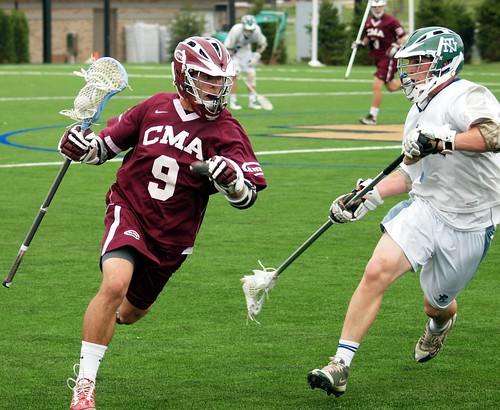 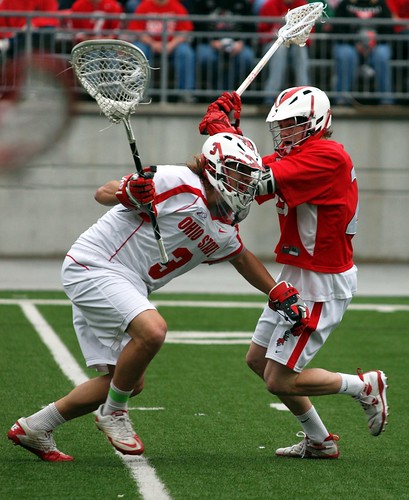 The womens game has similar movement but players do not wear protective padding, save for a small visor/mask around the eyes. As such there is no body checking. I also once heard the masks described as "Lew Alcindor goggles", which amused me. 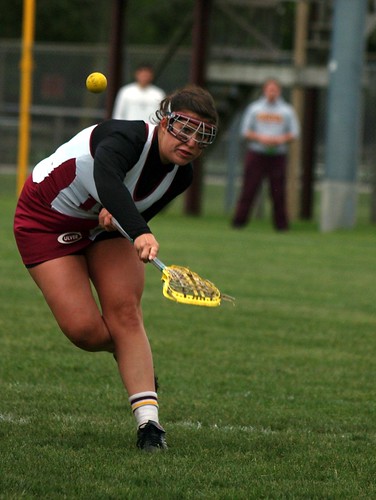 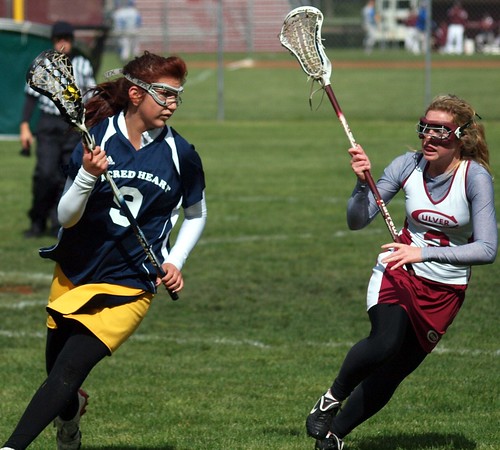 The game isn't quite as fast-paced as the men's version, which can make your life a little easier. I'm not as well-versed with baseball/softball, cycling, racing, soccer, etc, so if anyone wants to do a write-up on anything else, go ahead and I'll add it here. 
DJExile fucked around with this message at 20:40 on Jul 7, 2011 |
|
|
|
Honestly the best advice on panning is practice practice practice. Everything is going to vary in speed, and on how far you are from the subject. The good thing is you can practice on drat near anything. Cars driving by, a friend on a bike, etc.
|
|
|
|
HookShot posted:What kind of shutter speeds are you generally looking at when doing panning shots? 1/10 of a second? 1 second? It would depend on the speed of the vehicle and how far you were from it, but you're going to be 1/20 probably at the fastest. A full second would be all but impossible without a tripod.
|
|
|
|
2nd post updated with some football, hockey, and lacrosse ideas. Anyone wants to do a writeup on other sports, go ahead and I'll add them in.
|
|
|
|
Last Sports thread was fantastic about getting me (and I'm sure, others) to improve with a lot of constructive criticism. I'd like to hope this stays that way and doesn't just become an image dump. Not saying you have to put critique with every post like in PAD or something, to be sure, but let's try to keep it friendly.
|
|
|
|
hhaha I love that kid looking surprised to see you.
|
|
|
|
azathosk posted:I could try to do a writeup on association football. Not a pro though. Go right ahead!
|
|
|
|
HookShot posted:Ok, cool, thanks for this. Gonna sit by the highway and practice panning one day. That's honestly as good a method of practice as any.
|
|
|
|
SwiftTheFox posted:My job held a tennis tournament for the first time, and I was asked to take the photos. I usually take photos of the golf tournaments we have, but this was a new experience for me. I really wish my 5d mkII had better burst speed. Your last 3 are your strongest and the 4th from last could do with a pretty generous crop. Tarepanda is right about the background but that's not really up to you. What were you using?
|
|
|
|
SwiftTheFox posted:5d mkII, canon 70-200 f4, canon 85 f1.8, and a sigma 50mm 1.4 Nice, that should take care of a lot for you. Don't be afraid to take some generous crops at times either. Ordinarily you want to keep things as tight as possible. In other news, here are the 4 things you need to shoot a sailboat race (Not exactly the America's Cup, it was like 20 Sunfish and a few Lasers  ). ).   Pictures of the race to follow.
|
|
|
|
Unless I'm wrong, triatholons and bike racing are almost always outdoors, so ISO performance isn't as much of a worry compared to other events. Burst speed may not be either since you have constant motion (running, biking, swimming) instead of something that can happen very quickly (ball being thrown, kicked, etc). Anywhere from 3-5 FPS should suit you fine and drat near every entry level DSLR should handle that. Focus is part the camera and part the lens. I'd say a bit more the latter but that's me. As for Nikon or Canon, get your hands on either one and see what fits you best. Both have very good entry to mid level bodies available, and their used/refurb market is enormous and should save you some good money. Far as focal length goes, a 50-200 or 70-200 should suit you just fine for events like those. You shouldn't need anything longer. I don't know about the Nikon or Canon entry level 70-300 lenses but if they're anything like my old Oly 70-300 f/4.0-5.6, it won't be great.
|
|
|
|
Is rally as difficult to shoot as it looks like it might be? Seems like you're combining the difficulty of panning with dirt kicked up everywhere and cars jumping every 20 feet. Not to say your shots aren't good, MO-IV, they are, just seems like it could get really tough at times.
|
|
|
|
Auditore posted:I shoot rugby Goddamn this is great. I'd crop it from the top a bit but I just love this shot.
|
|
|
|
Trambopaline posted:Med school had a sports exchange with the other schools in the nation and I got a chance to give Rugby and Soccer a shot, but I feel like I'm really missing something with these photos. We've got an exchange where we are playing the law school this weekend, and I'd love a little feedback/general advice. You're capturing good action but in almost every case you want the aperture much larger than f/9. What lens were you using?
|
|
|
|
BobTheCow posted:Also try shooting from lower, kneeling or sitting. This is a really good point. Always helps to make the athletes look bigger, and it's especially good when players are bent over or crouching (rugby scrums, football snaps, lacrosse/hockey faceoffs, etc). This was laying prone: 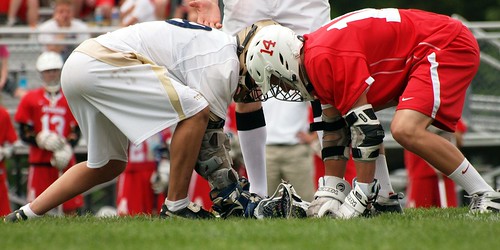 This was standing:  Now in fairness, I'm 6'6" so pictures of most people while I'm standing are going to make them look shorter.
|
|
|
|
Trambopaline posted:The f/9 has been a bit of a compromise because of the slow AF of my cheap and nasty (in the grand scheme of things) Canon XS/75-300mm f4-f5.6 III. I had a bit of trouble keeping things in focus, so essentially I was just trying to bracket the depth of field. That's fine, prefocusing to an area and waiting for action to enter the DOF isn't a bad thing (although it can be difficult), but go pull up any DOF Calculator and do some number crunching to see what might work better. f/9.0 at most sports distances is an enormous depth of field, and you can probably make do with just holding it at f/5.6 in most cases.
|
|
|
|
The Sheriff Jake posted:
Are those just some crazy gloves or are his fingers duct taped? In other news... It's baaaaaaaaaaaaaaaccccccccck for the weekend, anyway   More to come sometime this weekend E: Oh god I am excited to shoot hockey again, something is horribly wrong with me DJExile fucked around with this message at 06:14 on Jul 30, 2011 |
|
|
|
Star War Sex Parrot posted:Should I crop it tighter? I have ~1000 more shots of skiing and wakeboarding to go through and this is all new to me. It depends. Here, a wider crop works because you get a great spray and rainbow in the shot. At the same time you're not so tight on the right side that the skier doesn't have anywhere to go, so to speak. That said, getting in closer to get expressions and hard cuts can work well also. The good thing is sports like this are a little more flexible in how much you fill the frame with the subject.
|
|
|
|
INTJ Mastermind posted:A friend of mine is on a local softball team and I was planning on shooting one of their games this Friday. It's scheduled for 6 pm, which is like 1-2 hours before sunset. Yeah, leave the flash in your bag unless you want it for group shots, it'll only be distracting. If you're having a hard time with shutter speeds later in the game, you could try slowing it down a bit to get that cool blurry effect with batters. In terms of timing, fire your shutter about half a moment before bat meets ball (or ball meets glove on a throw to first, etc). It'll take some doing but with a little practice you can get really good with your timing, especially if somebody belts one over a 15' wall and dents a roof of a minivan like this kid:  a foolish pianist posted:Are there any good systems for keep a camera accessible but also out of the way for steep or hard hiking? I hate stopping, unstrapping my pack, taking out the camera, shooting a few photos, and then putting it all back. I believe there are chest rigs by Lowepro and some others (Kata jumps to mind but I'm not sure on that) and plenty of those holster-like bags can be rigged to them either on your chest or off your hip on specialized belts of theirs. Also that's a great view.
|
|
|
|
Beer leagues are awesome practice for sports work. Action is predictable and you can really work on your timing, practicing angles, etc.
|
|
|
|
Well goddamn does this own.
|
|
|
|
The Sheriff Jake posted:
This is an even better story with the guy's right arm being all bandaged up.
|
|
|
|
azathosk posted:
This is pretty slick right here. I'd maybe change the crop to give more room on the right, less on the left, but it's a great moment.
|
|
|
|
azathosk posted:Thanks! Yeah, I was considering putting him more in the centre of the image. Too much space? Much better. You can tighten it up from the top a little but that's pretty nitpicky at this point. E: Oh that's a lovely avatar someone got me 
|
|
|
|
Who said you can't shoot football at silly apertures like f/16? 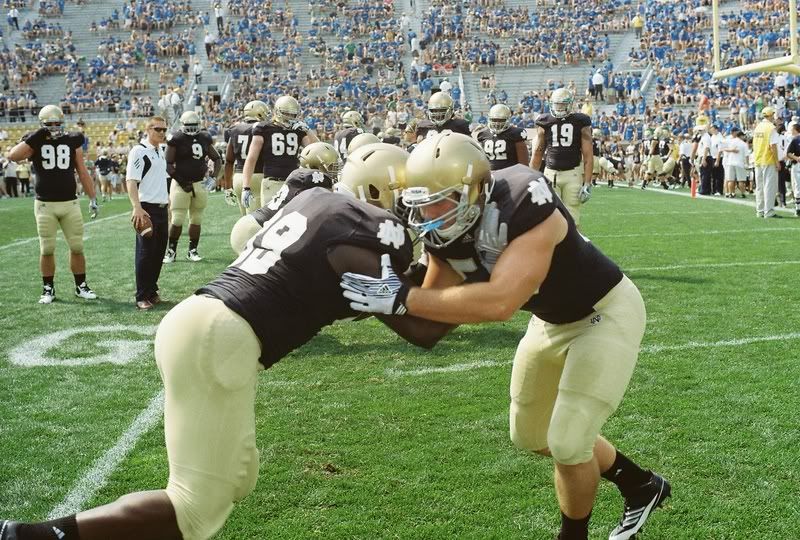 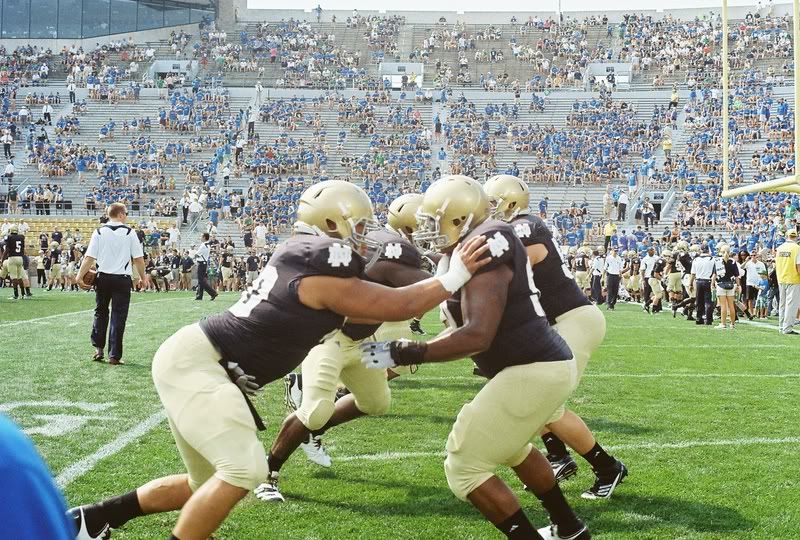 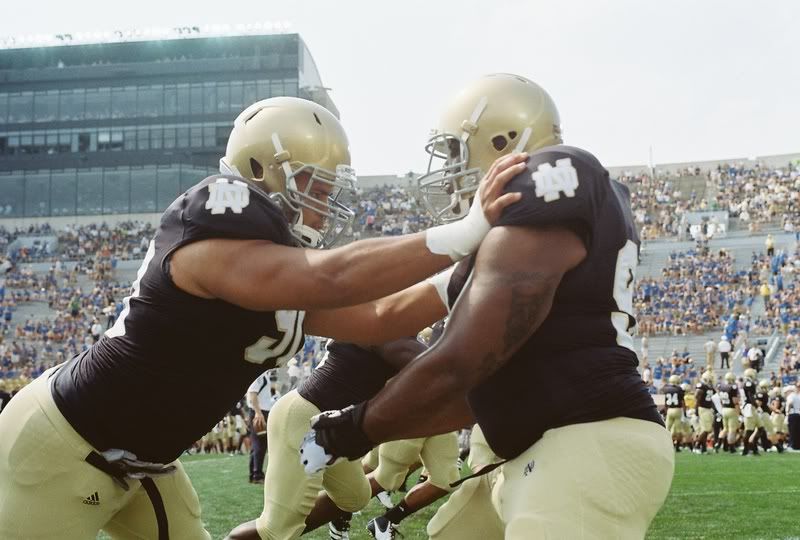 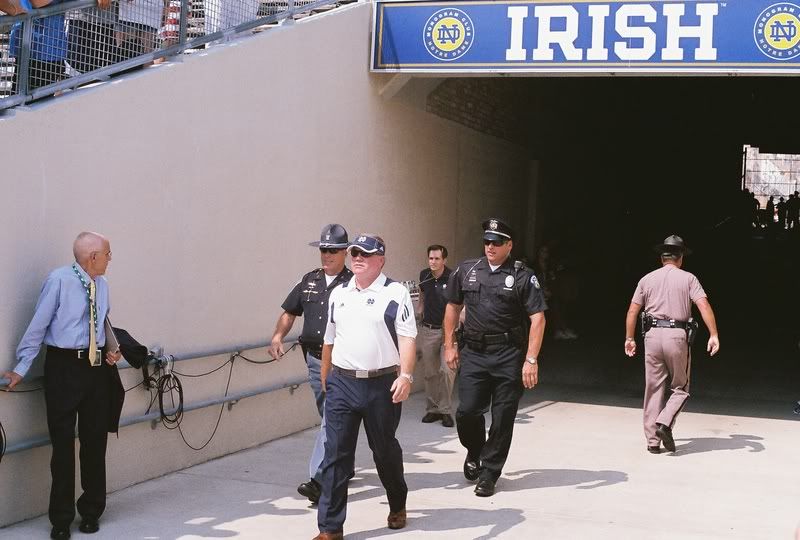 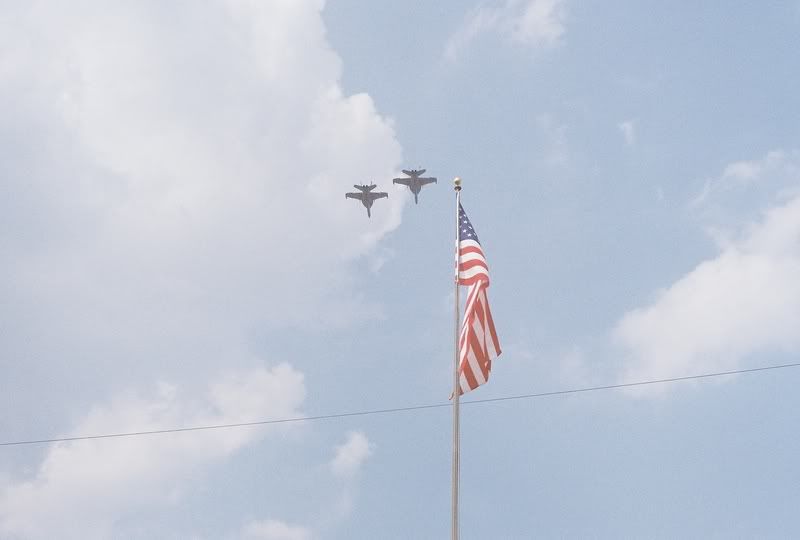 Fuji 400 film Olympus OM 50mm, I think everything was at f/16, maybe one of the players was at f/11, I can't remember.
|
|
|
|
BobTheCow posted:DJExile, do you work for/with Notre Dame? Secondly, can I be you? The day job has me doing some work for the staff. I was surprised how well these turned out. The prints look a ton better than the scans do.
|
|
|
|
They're all great but drat that last one is really nice. Digging that shoulder trim on their jerseys too.
|
|
|
|
BobTheCow posted:As much as I've shot field hockey, I still don't understand the drat sport at all. So many whistles! I think AIIAZNSK8ER put it very well in the last thread when he said the point was to put girls in short skirts and make them bend over for an hour.
|
|
|
|
This rules right here.
|
|
|
|
dakana posted:My buddy at WSPD said "if I was coach I would take that whole team into Savage Arena and pelt them with flags for 20 minutes"
|
|
|
|
xzzy posted:Yeah, that sounds like a heap of fun. I know there's some guys in here that photograph a lot of hockey, I'm sure they'll turn up and chime in before long. You rang?  Short version: Using anything slower than f/4 is pretty much useless. If it's a decently lit rink, that will help in spades. Do anything you can to get in the corner. Ideally, the glass will have portals cut into them made just for photographers. Shooting from the bench gets you some faceoffs, any shots of the coaches, and not a lot else, since action in either zone will involve players looking away from you. Plus benches are obviously crowded. I'd leave the 20mm at home, and maybe the 35 as well. If lighting is that bad, neither of those will get you anywhere near the action anyways. The 18-55 is probably also useless unless you want a wide shot somewhere. You'll probably want center or spot metering as hockey rinks are surrounded by dark seats and shadowed areas that won't help the player stand out. I've got a much bigger hockey write-up in the OP if that helps too. E: Almost forgot, W/B off the ice or (ideally) a white jersey. Auto will not work.
|
|
|
|
Sevn posted:Thanks! I will find your original post, does it have info about the 70-300 for Nikon? A little slow but can't I just push the ISO up on the D7000? It seems to handle it like a champ. Pushing ISO will help shutter speed (you're going to want whatever gives you 1/320 at the very least), but it won't help your focus speed, which is critical in hockey. I shoot Olympus so I can't really tell you about Nikon's 70-300, sorry
|
|
|
|
a foolish pianist posted:The Nikon 70-300 focuses really fast. It should work well. If this is the case then yeah, that will help. The tough thing is you're just not going to be certain on a few things until you actually get there to find out what the lighting, positioning, etc, will be like for you. I'd arrive as early as you can and get some shots while teams are warming up. That'll help you figure out settings pretty quick.
|
|
|
|
Sevn posted:As always, thanks for the advice! If what my friend told me is anything to go by, he said I would have control to go anywhere I wanted. I think I will take a few of my lenses this weekend and get a feel for it, try to meet the people who do the hiring, and then see if I need to jump on the 70-300 as soon as possible. Ask if they have portals cut in the glass at the corners, because you do not want to try shooting through plexiglass.
|
|
|
|
Yeah, in almost every case, lower to the field/ice/court/etc is better than above.
|
|
|
|
For anyone watching TV, if you turn on ESPN, odds are you'll see our boy Dakana somewhere on the sidelines.
|
|
|
|
dakana posted:
HA! I knew that was you Also that shot rules. E: Permit me a rant for a second. Apparently all bags/purses are forbidden at Michigan Stadium, and even a 1970s film camera (an Olympus OM-1) is disallowed because IT HAS A DETACHABLE LENS  gently caress that and gently caress them. gently caress that and gently caress them.
DJExile fucked around with this message at 23:18 on Sep 17, 2011 |
|
|
|
A5H posted:Properly awesome man! Love seeing you progress! It's literally impossible to shoot super slow pans at like a 3/4 angle because of movement which is a shame. This is a really cool idea and I'd love to see more of it.
|
|
|
|

|
| # ¿ May 1, 2024 23:58 |
|
Interesting story out of MichiganESPN posted:ANN ARBOR, Mich. -- Dennis Talbott, the businessman and freelance photographer who has been linked with former Ohio State quarterback Terrelle Pryor in a scandal involving autographed memorabilia, has been banned by the Michigan athletic department.
|
|
|



